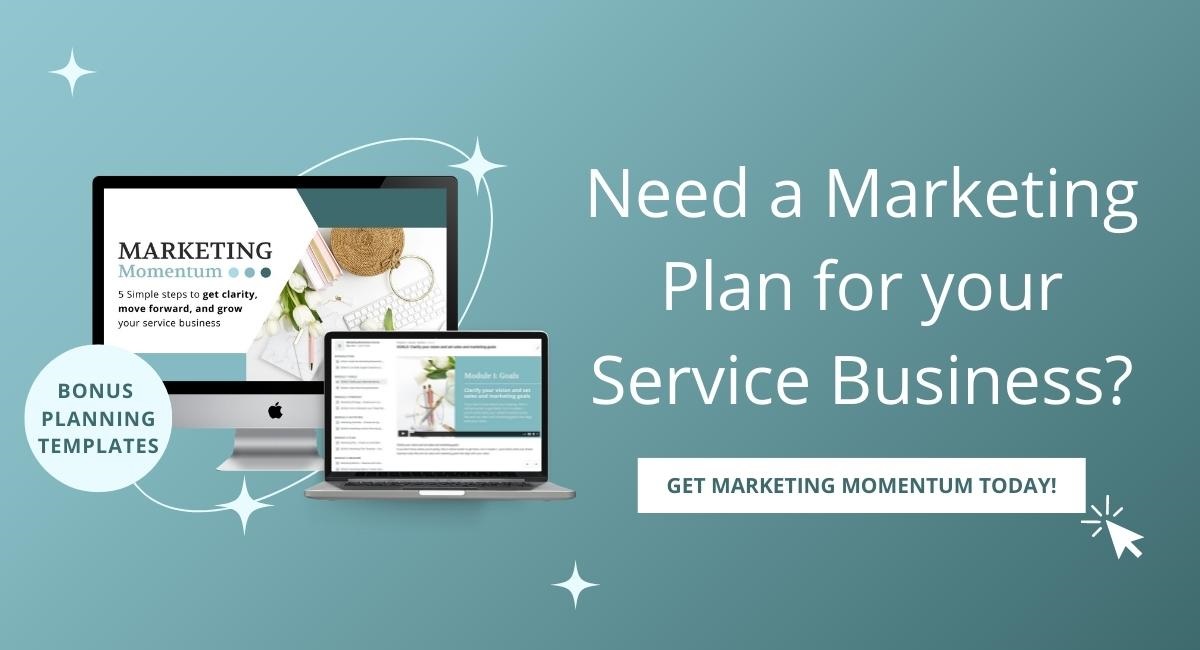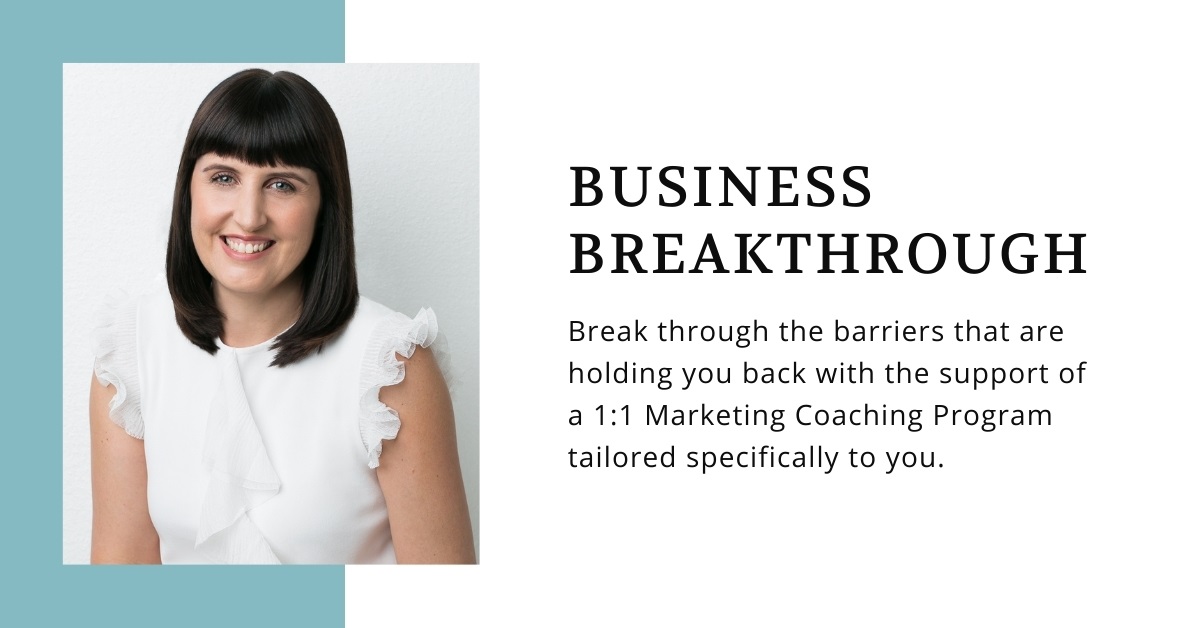7 Steps to setting marketing goals you’ll actually achieve

Setting marketing goals or objectives for your service-based small business doesn’t need to be a complicated process.
It’s simply a matter of determining what you want to achieve, and then following a goal-setting process that enables you to do it.
I recommend that a marketing goal-setting process take specific things into account, such as:
- Where you are now, and where you want to go
- The SMART way to define marketing goals and objectives
- What roadblocks or challenges you’ll need to overcome
- The solutions required to achieve success
- What resources and investment you’ll require
- How to prioritise activities and set milestones
- A system for tracking and monitoring your progress
Also, there are steps you can take to help you to stay on track to achieving your marketing goals.
These include writing down your marketing goals and placing them where you’ll regularly see them.
Plus, communicating them to your team, or finding an accountability partner who can hold you accountable and provide support when needed.

Below, I outline my 7-step goal-setting process and give you the steps you’ll need to take action and achieve marketing success.
It’s a goal-setting process I’ve used many times before, and one that you can easily follow too!
1. Analyse your current situation
It’s essential to start from where you are when it comes to setting marketing goals for the future.
Analyse what stage of business you’re in now and determine the shift you want to make.
Are you in a start-up or growth phase? Or, have you progressed to a stage where you’re seeking to scale?
Also, consider where you are regarding the size of your client list, your services, and your sales turnover.
From here, work out where you want your business to be within the timeframe for which you’re planning.
How much growth are you seeking, and in what areas?
Once you know where you are, and where you want to be, then it’s time to work out what gap you have between those two places.
When you know what gap you’re trying to close, then it’s much easier to determine what action you can take to make the most significant impact on your business growth.
2. Identify one overarching marketing goal
In your gap analysis in step one, you identified the main area in which you would like to grow.
Perhaps you want to increase the number of leads you’re generating to increase sales.
Or, maybe you’re seeking to introduce a new service to expand your revenue streams.
Alternatively, you may seek to streamline your systems and processes to free up more time to serve clients in your business.
Choose this one main area and use this to set your overarching marketing goal.
Having just one overarching marketing goal will help you to stay focused and ensure you actually achieve it.
Whatever goal or marketing objective you identified, it’s essential to define it using the SMART goal-setting principles.
Whatever goal or marketing objective you identified, it’s essential to define it using the SMART goal-setting principles. #marketing #goalsetting Share on XIf you haven’t heard of the SMART principles before, then it is an acronym for specific, measurable, achievable, realistic, and timely.
When setting a SMART marketing objective or goal, you want to ensure it meets each of the criteria above.
Let’s break down each of those criteria using the example of launching a new service offering:
Specific – I’m going to create and launch a new $2,000 service package
Measurable – I want to sell 2 packages per month
Achievable – I already have an email list of 5,000 people whom I can market this to
Realistic – My service package and pricing are in line with my competition
Timely – It will be launched in time so that I can sell 6 packages in the quarter ahead
Using this example, I would define my SMART marketing goal as:
At the beginning of this quarter, I will launch a new $2,000 service package and bring on 6 new clients to achieve sales of $12,000 for the period.
Now that you have a SMART marketing goal, it’s time to review any challenges or roadblocks in achieving your target.
3. Review your current challenges or roadblocks
No matter the goal, you’ll always have challenges or barriers you’ll need to overcome to achieve it.
In planning terms, these are known as your constraints.
These could include the need to upskill in an area, build a new service offering, design marketing templates, craft a message to communicate with your audience, update your website or technology, find the time and money needed to promote your offer or some other challenge which is standing between you and achieving your goal.
At this step, write down all the current challenges and roadblocks you have that specifically relate to your marketing goal.
What’s stopping you from achieving this goal?
What’s holding you back or needs to be completed first?
Now, summarise your list of challenges into 5 – 7 main roadblocks, which we’ll review in the next step.

4. Determine what solutions you’ll need to achieve your marketing goals
Against each of your main challenges, write the solution you’ll need to deliver to overcome that challenge.
For example, if you don’t have the skills to implement a new technology you’ll need, could you upskill and learn how to do it?
Or, do you have the money to outsource it to someone who could do it for you?
Another example could be that you don’t have the marketing templates and assets designed to promote your offer.
In this case, could you allocate the time to create these templates? Or, hire a graphic designer to do it for you if you don’t have the time?
Once you’ve listed your solutions to these challenges, then these become your sub-goals to your main overarching marketing goal.
You’ll need to deliver the smaller steps to achieve your primary marketing goal.
Not sure where to start when it comes to marketing your service-based small business? That’s where I can help. Get started by downloading my free Ultimate Marketing Checklist by clicking the button below:
5. Allocate the required resources
The next step when setting marketing goals is to review all the resources you’ll require and allocate the appropriate time and/or money you’ll need to invest against each sub-goal.
Once you review this part separately, you may realise that you don’t necessarily have the amount of time or money required to deliver your solutions or sub-goals within the timeframe.
At this point, it’s time to either go back and adjust your goal to become achievable and realistic, as we covered in the SMART goal-setting principles above.
Or, you can bring on additional resources to help you achieve your marketing objectives.
Allocating the required resources or bringing in support now is critical to determining whether you’ll achieve success.
You’ll want to ensure you’ve planned for this properly in the beginning so that you’re set up for success and not for failure.
RELATED: 5 Things every small business marketing plan must have
6. Prioritise and set milestones
When setting marketing goals, one of the remaining steps is to prioritise the list of sub-goals you have to work on each deliverable in the right order.
This step is the point at which you’ll be able to determine if any of the sub-goals depend on the others.
In addition to prioritising, setting a milestone date for each step or sub-goal delivery is essential.
A key date or deadline will help you with the final stage of tracking and monitoring your progress against your goals.
Depending on the size of your sub-goal, you may want to also break these steps down further, so you have a more detailed list of actions and deadlines to work to in your action plan.
7. Track, monitor and adjust your marketing goals where necessary
If you’ve reached this point, then you’ll have written down one main marketing goal and a series of 5 – 7 sub-goals you’ll need to deliver to achieve your overarching goal.
To help you achieve your marketing goals, place this list where you will see it regularly to remind you where your focus should be.
You may even want to write it prominently on a whiteboard in your office!
It’s very easy to get distracted in a small business trying to do everything, so this will help remind you what’s important.
Decide how often you’ll review your progress against your goals and allow enough time to react and adjust if necessary before reaching your critical milestones.
If you miss a few of your earlier deadlines, you’ll know that you need to make adjustments or bring on some additional resources to help you achieve your marketing objectives.
RELATED: 7 Marketing metrics every service business should track
Finally, getting yourself an accountability partner or a Marketing Coach will help you to stay on track.
You’ll have another person holding you accountable and giving you the support and coaching you may need to achieve your marketing goals.
So, there is my 7-step marketing goal-setting process to help you set marketing goals you’ll actually achieve.
When you follow these simple steps, then you’ll be well on your way to successfully marketing and growing your service-based small business.
Tired of trying to figure out what you’re missing when it comes to finding clients and making sales in your service business?
Break through the barriers that are holding you back with the support of an MBA-qualified Marketing Coach and Business Mentor who will tailor a 1:1 program specifically for you.

BUSINESS BREAKTHROUGH is a 3 or 6-month 1:1 Coaching Program for service-based business owners who want to develop the strategy, systems, and structure they need to find clients and make sales, so they can stop feeling stuck and start gaining massive momentum in their business.
Did you find this post helpful? Please don’t forget to share on Facebook or PIN it on Pinterest.



